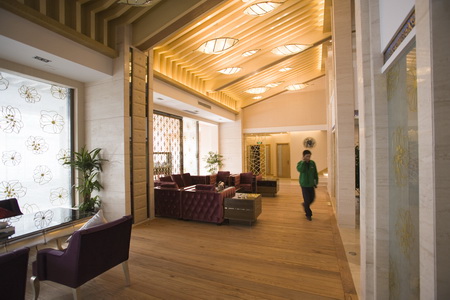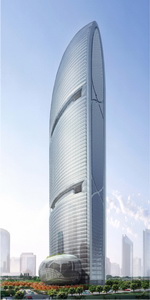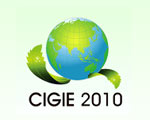Building a more environmentally-friendly future
By Qiu Quanlin and Wang Yao (China Daily)
2010-01-25 08:03
|
|
 |
|
Interior fixtures and amenities are luxurious. [China Daily] |
Baiju Woo, another chief engineer of the tower, said the 309-meter building was the first one on the Chinese mainland to integrate a high level of advanced sustainable technologies into its construction, including wind power, solar power, cooling radiation displacement, a ventilation system and a dual-layer curtain wall.
The tower, with a gross floor area of 210,000 sq m, will become a landmark office building in the Pearl River Delta region, said Ye Zhiming, general manager of the Pearl River Tower Real Estate.
"It is of great significance to develop sustainable green office buildings in Chinese cities," he added.
Amenities in the building include exclusive VIP clubs, fine restaurants, banks and convention and exhibition facilities. They meet top office requirements, according to Ye.
Colliers International, one of the leading advocates of the green office environment among real estate agencies, has been appointed as the marketing and leasing agent for the building, Ye said.
"The tower, with its high level of environmental protection, will help demonstrate that office buildings in China are on a par with international standards," said Jamie Horne, president of Asia Pacific at Colliers International.
 |
|
The Pearl River Tower cuts a fine figure but it is contemporary in more than one sense. [File photo] |
Chinese experts are calling for more construction of eco-friendly building such as the Pearl River Tower to help save energy.
Late last year, China set a goal of slashing carbon emission per unit of economic output by 40 to 45 percent by 2020 compared with the 2005 level.
"Worldwide, buildings consume about 40 percent of energy, so it is very urgent to develop environmentally friendly buildings to reduce energy consumption," said Meng Qinglin, a professor with the Architecture and Design Institute at South China University of Technology.
Meng suggested more energy-saving technologies be adopted in buildings, including residential houses and sports facilities.
"They should be designed in harmony with the environment," Meng said, citing technologies used in the building of the Guangzhou Asian Games Town.
The town, which is situated in Panyu district, is equipped with a renewable energy system that could generate electricity through collecting sunlight to help provide water heating and air conditioning if there was a power cut during the games. It would also help reduce energy costs for the town's residents after the games.
Various renewable energy resources will be employed, such as solar energy and hydropower - produced in nearby rivers - while solar energy will be collected through systems placed on the top of each building in the town.
|
||||
According to the Chinese Academy of Engineering, China produced as much as 5.96 billion tons of carbon in 2007, 140 million tons more than the United States.
The country faces a very difficult challenge in saving energy, with the per capita carbon emission surpassing the world's average of 4.18 tons to reach nearly five tons in 2008, said Meng.
Buildings in China will likely consume 2.6 billion tons of standard coal by 2030 if the country does not introduce stricter controls on projects with high-energy uses, Meng said.







